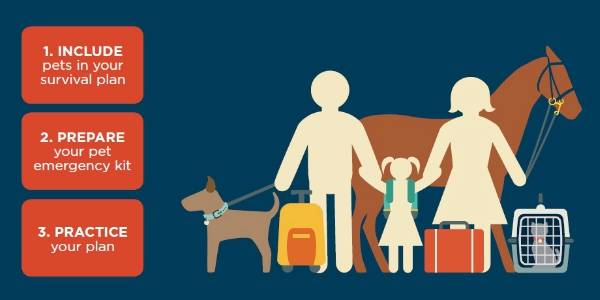How to keep your animals safe during emergencies and disasters
Just as we need to prepare our family and property in times of emergencies and natural disasters we also need to prepare our animals.
After human safety, the welfare of your animals should be your most important consideration in the event of a natural disaster. It is up to you to plan ahead and be prepared before an emergency happens to ensure the safety of yourself and your pets.
Know the risks in your area and plan ahead
In South Australia, natural disasters that may occur are bushfires, extreme weather (storms, floods, heatwaves) and earthquakes. You should investigate and understand the risks both in your area and in places where your animals may occasionally stay.
By planning ahead and acting early, you can avoid danger, panic and potentially fatal situations. Although individual needs will vary, the information on this page will help you to plan for the safety of yourself and your pets in emergencies.
This information is applicable to most household pets and assistance animals. For larger animals such as horses or livestock, more information can be found at Horse SA’s My Horse Disaster Plan and Primary Industries and Regions SA’s Animal Safety in Emergencies webpage.
The Pet Emergency Plan initiative is funded by the Natural Disaster Resilience Program, and has been developed by RSPCA South Australia in partnership with the Commonwealth and State Government of South Australia. The initiative is designed to ensure that South Australian pet owners are well prepared to protect themselves and their pets in emergencies.
3 essential steps to creating your Pet Emergency Plan
Step 1: Include pets in your emergency survival plan
It’s important to plan for how you will relocate your pets to a safer place and also what you will do if you can’t relocate and need to manage pets at home or on the property (for example: if an emergency happens unexpectedly).
To ensure you’re prepared:
- Train your pets to be settled in a cage / carrier / crate / horse float.
- Get pets accustomed to car trips.
- Pets may be relocated to a family member, friend, pet boarding facility, pet day care facility or pet-friendly accommodation located in a safe area. Keep in mind that the premise may have specific requirements – for example, boarding facilities require that pets are up-to-date with vaccinations.
- Keep vaccinations up-to-date and keep the certificate in a safe place.
- Ensure that cats and dogs are microchipped and have an ID tag including their name and your mobile phone number.
- Ensure that contact details are up-to-date on the microchip register. Dogs should also be registered with your local council.
- If you rely on an assistance animal for support, think about what you might do if your assistance animal becomes confused or is separated from you – are there other ways you can be supported?
Late evacuation can be dangerous. See our ‘Activating your plan’ section below for considerations about when to relocate.
Should an emergency occur without warning, such an unexpected fire, flash flood or earthquake, take action to shelter in place safely. See our ‘Managing pets in place’ section for full information.
Step 2: Prepare your Pet Emergency Kit
Preparing a pet emergency kit is an essential part of your planning process. It will ensure that you have everything you need in order to activate your plan quickly.
The kit should include:
- Registration certificates.
- Vaccination certificates.
- Transportation equipment (cages / carriers / crates / horse floats, etc).
- Cat litter and tray.
- Poo bags for dogs.
- ID tags (including pets name and your mobile phone number), collars, leads, harnesses, saddles etc.
- Food and water bowls, and at least one week’s supply of non-refrigerated food.
- Medications and clear instructions for treatment of any medical conditions.
- Blankets / bedding / nesting material.
- Toys / enrichment devices.
- Photograph of your pets (including names) in sealed plastic bags.
- Contact details for your vet, local animal shelter, local council and alternative animal accommodation facility.
For assistance animals, you should also include:
- Evidence that your animal is appropriately trained to access public areas.
- Instructions on how the animal is to be treated by others assisting after an emergency, if there are specific requirements they may need to be aware of.
Step 3: Practice your emergency survival plan
Practicing your emergency survival plan is a vital part of your preparation. Practice will help you to refine your plan, and prevent panic in the event of a real emergency.
Your Pet Emergency Plan should form a key part of your overall survival plan for the types of emergencies that might be relevant to you. For more information on preparing your Emergency Survival Plan, please click here.
Activating your Pet Emergency Plan
You need to decide what will trigger you to activate your plan and when this may involve relocating your pets.
To avoid unnecessary risks to you and your pets, move them to a safe place when emergency conditions are forecast (for example: catastrophic fire risk declared for next day or a flood watch warning issued). Spending a short time away is better than taking the risk of being caught out or trapped by rapidly changing life-threatening conditions.
You may also need to relocate in response to a warning about an emergency event in your area (for example: Watch and Act warning issued for fire event).
If relocating, consider the following:
- Small pets should be contained within the home at the first sign of an emergency. This ensures they are close at hand if you make the decision to evacuate.
- Phone ahead to confirm arrangements with the safe location you have designated in your emergency plan.
- Pack your Pet Emergency Kit in your vehicle.
- Allow additional time for the special needs of some pets;
- Carry birds, rabbits, guinea pigs, mice or other pocket pets in cages or in secure boxes with small air holes.
- Put fish in a large wide-necked jar with a secure lid. Fill the jar two-thirds with water. Regularly blow through a straw into the water to aerate it.
- Frogs need a small covered tub with 2.5cm of water and air holes in the top.
- Snakes and lizards need a container with a secure lid and air holes. They may also be transported in a sack or pillowcase that has been securely fastened at the opening.
- As poultry and aviary birds are easily affected by smoke, make a hessian covering to fit the cage. To use, wet down the covering and secure around the outside of the cage.
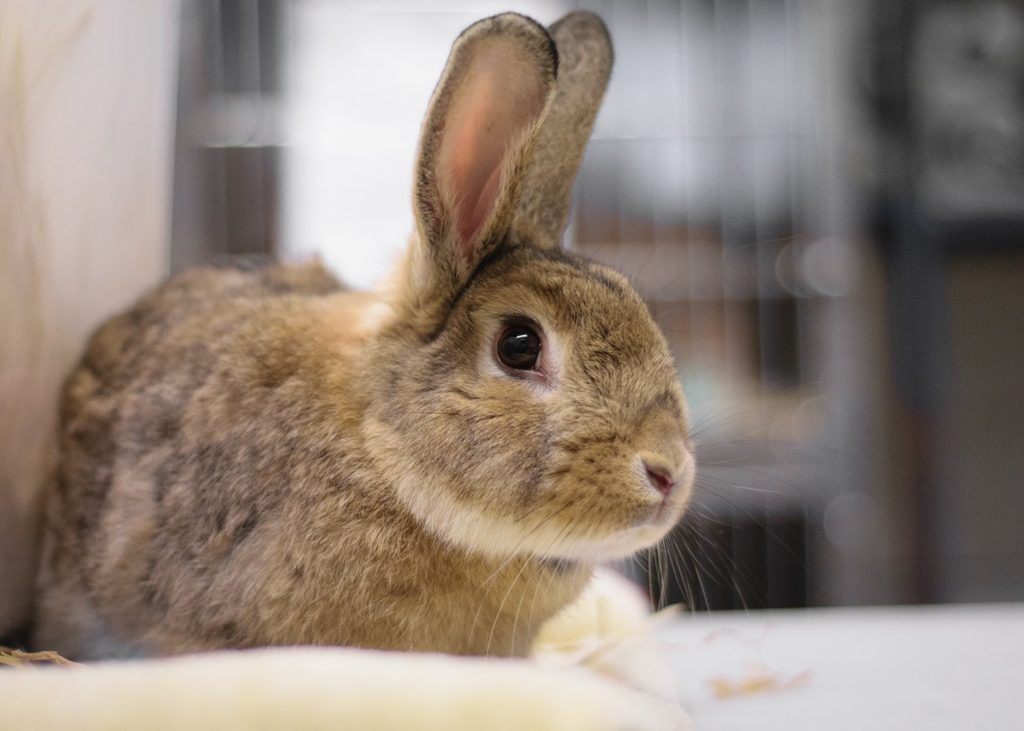
Managing your pets in place during emergencies
Pets should not be abandoned unless it is impossible to safely evacuate them. If a disaster strikes without warning it may be too late to leave safely – you and your pets may need to shelter in place.
If you cannot evacuate or are forced to leave your pets behind, be sure to follow this advice:
- Do not tether pets (tie them up) as they will be unable to flee if danger is imminent.
- Provide food and water for at least one week in accessible places and in more than one container that can’t be tipped over.
- Ensure pets are easily identified (for example a collar with a name and phone number and up to date microchip details).
- Leave a note on the front door or on your mail box stating your mobile phone number, how many pets are located on the premises, their species, names and a photo.
- Birds will require food dispensers that regulate the amount of food provided at any one time. Ideally these dispensers will be provided for all pets.
- In the case of flood, position a heavy chair or crate to allow access to a higher refuge such as a bench, vanity unit or shelf where adequate food and water should be left.
If possible, leave your pets indoors:
- If you are home, shut your pets inside the house so they are close by and can exit with you once the danger has passed.
- If you have to leave pets behind alone, leave your pets in a safe, secure room. Ideally this room would have no windows, and must have adequate air (for exampe: a big bathroom).
- Avoid rooms with hazards such as large windows, hanging plants or large picture frames.
- Don’t confine dogs and cats in the same space.
If you have to leave your pets outside:
- Ensure there is plenty of water available from a source that does not rely on power or above-ground pipes.
- In a bushfire, move pets to a closely grazed or ploughed paddock (preferably around the homestead) with drinking water, steel fencing and preferably shade. (Poultry can be placed in a temporary pen.)
- In a flood, move pets to high ground with adequate natural feed. Additional feed may be required for stock stranded for extended periods.
- In a severe storm (including hail) or a cyclone, place pets under solid cover (for example: a sturdy barn / shed or covered pen).
- Do not shut horses in stables or small fenced yards. Sand arenas, grazed down paddocks or similar bare areas are best.
- High visibility pet coats and horse rugs with your mobile phone number can also be helpful to assist in the relocation of lost pets – but horse rugs, halters, fly veils, etc, are best removed during floods or fires, as they may become caught on objects or melt onto skin during intense heat.
- Do not place synthetic blankets on your horses, as these may melt during extreme heat.
- Provide a minimum of five days’ supply of hay or ensure access to pasture.
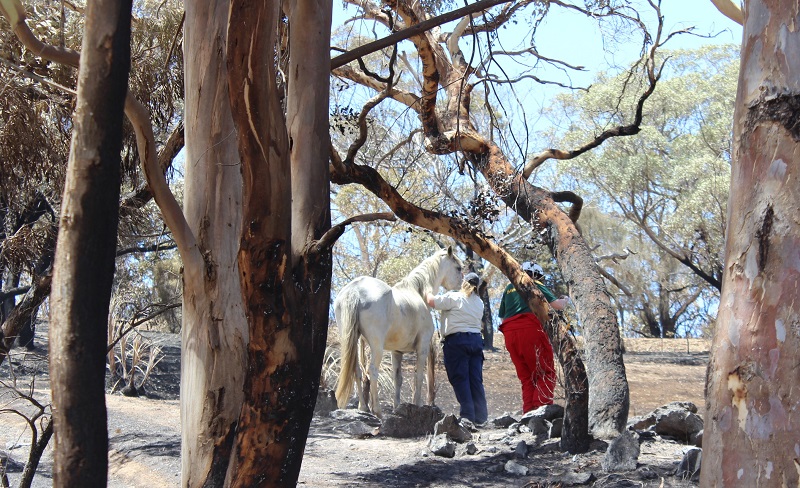
Specific hazard information: thunderstorms, heat waves, bushfires and earthquakes
Earthquakes
Pets may run for shelter in an earthquake – if there is any advance warning, such as a tremor, bring dogs and cats immediately inside your home.
However, it may be too difficult to manage all pets while an unexpected earthquake is happening – protect yourself and your family as the priority.
During the earthquake itself, do not attempt to hold or restrain a dog, no matter the size or usual friendliness – the panic and anxiety of experiencing an earthquake may deeply unsettle a dog, making it more likely to react aggressively.
If it does not compromise your own safety, quickly move caged pets in your home that are easy to handle and easy to access (for example: already in the same area as you are) to a safer place at the onset of an event. Safer places include: under heavy pieces of furniture, such as a desk or sturdy table; under supported archways; and against inside walls. Be aware that aftershocks also may occur.
Bushfires
Lives were lost in the 2009 Victorian bushfires when people made the decision not to evacuate because they did not want to leave their pets. Many pets also perished because they were not evacuated in time.
In January 2015, a major emergency was declared as bushfires broke out near Sampson Flat in the Adelaide Hills. This was a reminder that the threat to South Australian’s is real.
Please plan ahead using our three-step process and be prepared before an emergency happens to ensure the safety of yourself and your pets.
Extreme heat waves
Multiple steps can be taken to help protect your pets against heat stress, dehydration and possible collapse. Paramount is ensuring animals always have access to shade and cool water. Animals also should not be transported during high temperatures unless it is absolutely unavoidable.
For a full list of tips on preventing heatstroke in animals during heat waves, please click here. You can also find information on avoiding stress in farm animals and wildlife.
Thunderstorms
Thunder can be very distressing for pets. To keep them safe and prevent them from running away, keep them calm indoors with sufficient running space and access to food and water.
A Thundershirt for your dog or cat is also a great way to keep them calm from anxiety in stressful situations such as thunderstorms.
In the event that your pet does become lost during a storm, please click here to search for found animals in RSPCA South Australia’s shelters, and for more information on finding your lost pet.
After an emergency: relief and recovery
In the event that your pet does become lost during an emergency, please click here to search for found animals in RSPCA South Australia’s shelters, and for more information on finding your lost pet.
After an emergency, you may need to:
- Check your pets for any injuries and seek medical attention if required.
- Survey your property for hazards such as sharp objects, dangerous materials, live wires and contaminated water.
- Check fences and enclosures – find safe and secure areas to release animals into (during daylight) or find other temporary accommodation/agistment.
- Watch your pets closely for the first few hours – often familiar areas and scents have changed which can confuse your animals and alter their behaviour.
- Seek emergency food and water if supplies are damaged.
- If your pets have been without food for a long period, reintroduce food slowly and in small portions.
- Allow free access to clean water – do not give cold water.
- Allow uninterrupted rest to recover from trauma or stress. Be patient with your pets after a disaster. Try to get them back into their normal routines as soon as possible, and be ready for behavioural problems that may result from the stress of the situation. If behavioural problems persist, or if your animals seem to be having any health problems, talk to your vet.
Please note that if you have relocated, roads may be closed for some time and you may not be able to return to your property until the area is deemed safe.
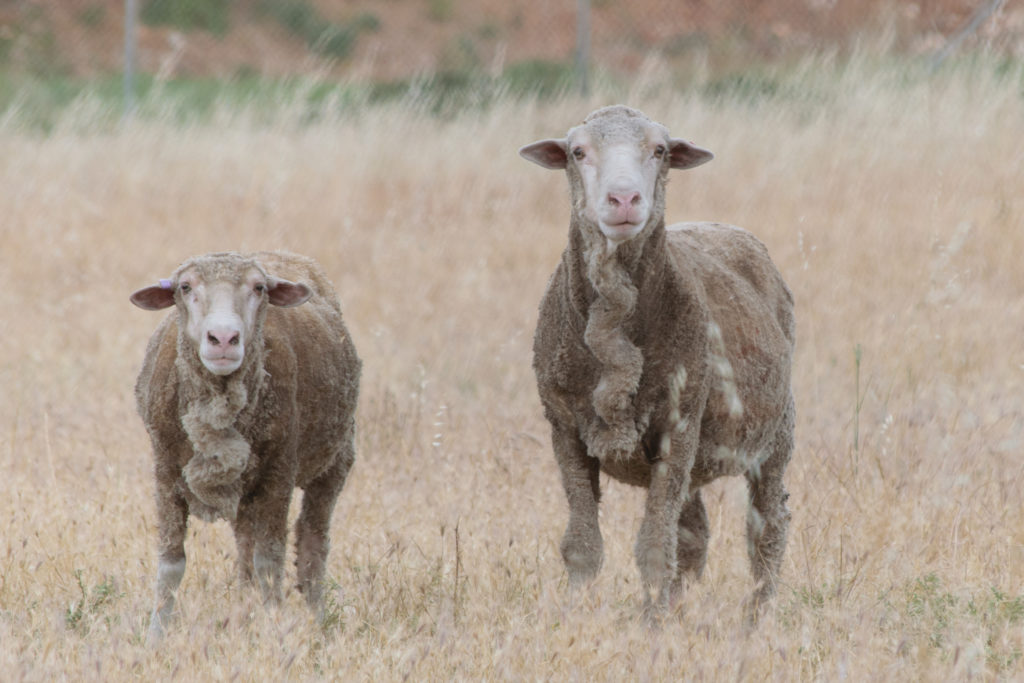
Support for animal welfare after disasters and emergencies
After a major emergency or natural disaster, normal services may be disrupted or overwhelmed and Primary Industries and Regions SA may activate ‘Agricultural and Animal Services’ (AAS).
- AAS provides relief support for emergency-affected animals through a range of organisations, including RSPCA South Australia.
- Full information about AAS services and other emergency arrangements that support animals can be found here.
At the time of a major emergency, updates about who to contact for animal assistance will appear on the PIRSA website.
A relief or recovery centre may be set up by Department of Communities and Social Inclusion to provide basic relief or recovery services to people affected by the emergency. Assistance animals are permitted inside but, due to health and safety, other animals must remain outside. Pet owners are responsible for the welfare of their pets at such centres. Support for animals at relief centres may be organised through AAS if required.
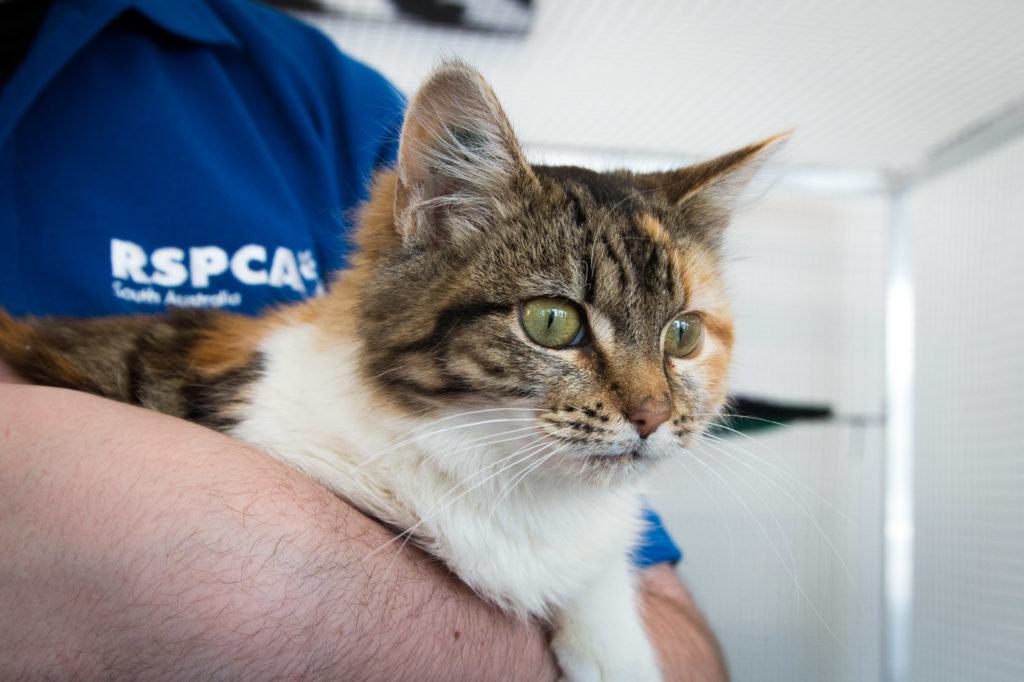
Further information to support your planning process
For more help and advice, please visit the following links:
- SA Government – Emergencies and safety
- Country Fire Service (CFS) – Prepare for a fire (general information)
- Country Fire Service (CFS) – Prepare pets and livestock for a fire
- Bureau of Meteorology – SA Weather and Warnings
- Horse SA – Emergency
- Primary Industries and Regions SA (PIRSA) – Livestock and other animal safety during and after emergencies
- State Emergency Management Plan – Guidelines for Planning for People with Assistance Animals In Emergencies
- Australian Veterinary Association – Animals and Natural Disasters
As you can see, with a little planning and foresight, you can be fully prepared before an emergency happens to ensure the safety of yourself and your beloved pets.


